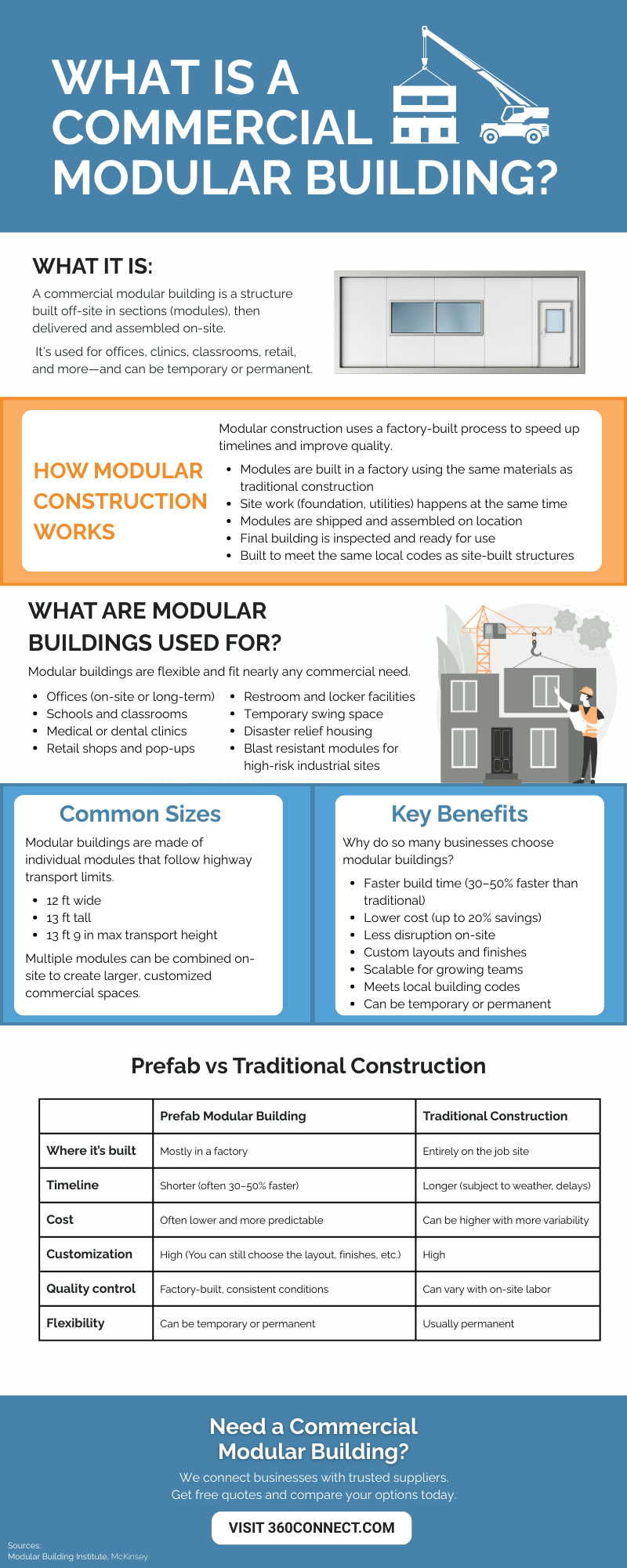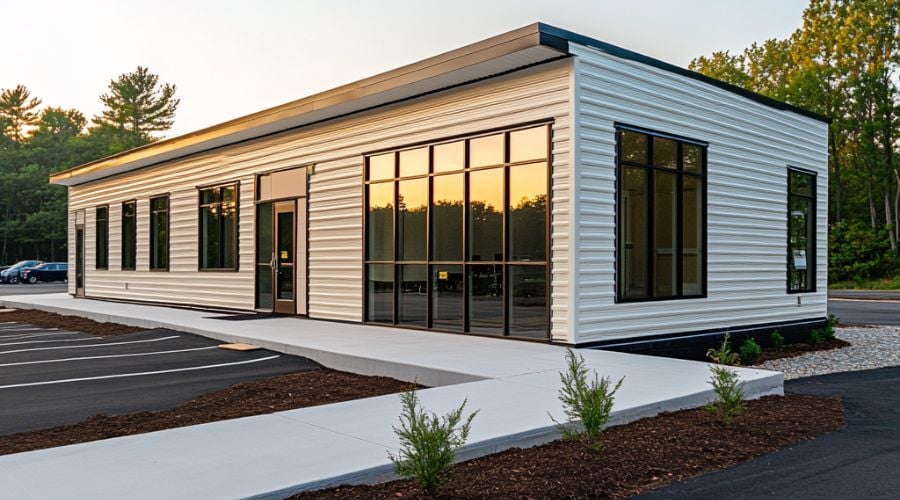If you’re looking for a fast, cost-effective, and flexible way to expand your business space, you’ve likely come across the term commercial modular building. But what exactly does that mean? Is it the same as a mobile office? Can a modular building really be a permanent solution?
In this blog, we’ll break down what a commercial modular building is, how it works, what it’s used for, and why businesses across industries are turning to modular construction.
What is a Commercial Modular Building?
A commercial modular building is a prefabricated structure designed for business use. It’s constructed off-site in a controlled factory environment, transported to the job site in sections (or modules), and then assembled into a complete building.
These buildings can serve a variety of commercial purposes—ranging from offices and classrooms to medical clinics and retail stores. Modular buildings can be designed for temporary or permanent use, depending on your needs.
The key difference between modular and traditional construction lies in how and where the building is constructed. While traditional buildings are constructed entirely on-site, modular buildings are built off-site—often reducing timelines and costs.

How Does Modular Construction Work?
The modular construction process typically includes the following steps:
1. Design & Planning
Everything begins with your vision. You’ll work with a modular supplier or manufacturer to determine the size, layout, and features you need. At this stage, you’ll choose materials, floorplans, and any customizations.
2. Site Preparation
While your modules are being built in the factory, the physical site is prepared—grading the land, pouring foundations (if needed), and installing utilities. This parallel construction helps reduce project timelines.
3. Off-Site Construction
Each building module is constructed in a factory-controlled environment. These modules include flooring, walls, electrical wiring, insulation, and interior finishes. Factory production also means better quality control and less exposure to weather-related delays.
4. Delivery & Installation
The completed modules are delivered to your location and assembled using cranes and support equipment. Modules are stacked or arranged side-by-side, depending on the layout.
5. Final Finishes & Inspection
Once assembled, crews connect utilities, complete final finishes, and conduct inspections to ensure everything meets local building codes.
What Can Commercial Modular Buildings Be Used For?
Modular buildings can be tailored to fit just about any business need. Some of the most common modular building uses include:
- Modular Office Buildings – For startups, construction sites, or temporary expansions
- Modular Classrooms & Educational Spaces – Used by daycares, K-12 schools, colleges, and training centers
- Medical Clinics & Healthcare Spaces – Ideal for urgent care, specialty practices, dental clinics, and vaccination centers
- Retail Stores & Pop-Ups – Flexible space for seasonal retail, food vendors, or expanding businesses
- Restroom & Locker Facilities – Especially useful at parks, outdoor venues, or remote job sites
- Temporary Swing Space – Used during renovations, emergencies, or relocations
- Disaster Relief or Emergency Housing – Quick deployment during emergencies or natural disasters
- Blast Resistant Modules – Designed for industrial or high-risk environments that require extra protection from explosions or hazardous materials
Because modular buildings are so customizable, they’re used across construction, education, healthcare, retail, hospitality, government, and more.
Related: Top 5 Commercial Modular Building Types
Are Modular Buildings Temporary or Permanent?
One of the biggest misconceptions is that modular buildings are only temporary—but that’s not the case. Modular buildings can be:
Temporary
- Leased for short-term needs (weeks to a few years)
- Easily relocated or removed
- Ideal for job sites, school overflow, or event space
Permanent
- Installed on a foundation
- Built to meet the same codes as traditional buildings
- Used for long-term offices, clinics, or classrooms
Many permanent modular buildings are virtually indistinguishable from traditional structures. They can include brick facades, pitched roofs, full HVAC systems, and high-end interior finishes.
Benefits of Commercial Modular Buildings
So, why are more businesses choosing modular construction? Here are some major advantages:
1. Faster Project Completion
Modular buildings are constructed while your site is being prepared. This can reduce build time by 30–50% compared to traditional construction.
2. Lower Costs
Fewer labor hours, shorter project timelines, and less material waste typically lead to significant savings. Modular buildings are also easier to budget, with more predictable pricing. In addition, a McKinsey analysis suggests that modular techniques could reduce costs by up to 20 percent.
3. Customizable Design
Modular doesn’t mean cookie-cutter. Choose from hundreds of layouts, finishes, colors, and features to match your branding and workflow.
4. Eco-Friendly
Factory construction produces less waste and often uses energy-efficient materials. Plus, modular buildings can be relocated or repurposed instead of torn down.
5. Scalability
Need to add space later? Modular buildings are easy to expand with additional units or reconfigure for future needs.
6. Reduced Site Disruption
Because most of the work happens off-site, there’s less noise, debris, and traffic disruption around your business or school.
Are Commercial Modular Buildings Code Compliant?
Yes. Commercial modular buildings are built to meet or exceed the same local, state, and federal building codes as traditional construction. This includes:
- International Building Code (IBC)
- Americans with Disabilities Act (ADA)
- Fire safety regulations
- Energy efficiency standards
Modular buildings also undergo inspections throughout the construction process—both in the factory and on-site—to ensure code compliance.
If you’re in a regulated industry like healthcare or education, modular manufacturers can include industry-specific compliance such as:
- HIPAA-compliant privacy design for clinics
- Specialized ventilation or clean rooms
- Child-safe finishes for classrooms
What Sizes Do Commercial Modular Buildings Come In?
If you’re thinking about getting a commercial modular building, it’s normal to start wondering—how big can these things actually be?
The answer? It depends. But there are some common limits to keep in mind.
Because modular buildings need to be transported by truck, their individual modules have to follow federal and state highway regulations.
That means there’s a cap on how wide and tall each module can be when it’s on the road.
Here are the most common dimensions for a single modular unit:
- 12 feet wide
- 13 feet tall
- 13 feet, 9 inches (absolute height limit for most highway transport)
That doesn’t mean your entire building has to fit within those dimensions—it just means each module does. Most commercial modular buildings are made up of multiple modules joined together on-site, so the final structure can be much larger than a single unit.
Need something taller or wider? That’s possible too—it just might require special permits or escort vehicles for transportation. A good modular building supplier will help you figure that out during the planning phase.
How Much Does a Commercial Modular Building Cost?
Modular building pricing varies depending on several factors, including:
- Size (square footage)
- Temporary vs. permanent
- Interior and exterior finishes
- Site location and accessibility
- HVAC, plumbing, and electrical needs
General Price Range:
- Temporary modular buildings: ~$50–$100 per sq. ft.
- Permanent modular buildings: ~$100–$200+ per sq. ft.
While modular buildings can cost less overall than traditional builds, it’s important to get detailed quotes based on your unique project requirements.
(Pricing as of 4/2/2025. Costs may vary by supplier and region.)
How Long Do Modular Buildings Last?
With proper maintenance, permanent modular buildings can last 30–50 years or more—similar to traditional buildings. Temporary buildings can last 10–20 years depending on climate, usage, and materials.
Regular maintenance (HVAC checks, weatherproofing, etc.) will extend the building’s lifespan and protect your investment.
How Does Modular Compare to Traditional Construction?
You might be wondering how a commercial modular building stacks up against a traditional build. The short answer? You’re getting the same structure—just faster, more efficiently, and often at a lower cost.
Here’s a quick side-by-side:
| Prefab Modular Building | Traditional Construction | |
| Where it’s built | Mostly in a factory | Entirely on the job site |
| Timeline | Shorter (often 30–50% faster) | Longer (subject to weather, delays) |
| Cost | Often lower and more predictable | Can be higher with more variability |
| Customization | High (You can still choose the layout, finishes, etc.) | High |
| Quality control | Factory-built, consistent conditions | Can vary with on-site labor |
| Flexibility | Can be temporary or permanent | Usually permanent |
Both methods meet the same building codes—so it really comes down to timeline, budget, and how quickly you need your space.
Who Should Consider a Commercial Modular Building?
Modular construction is a great fit if your business:
- Needs space fast
- Has a limited construction budget
- Requires a temporary or scalable solution
- Needs to minimize disruption during construction
- Operates in a remote or hard-to-build area
Whether you’re a school running out of classroom space, a clinic expanding services, or a company opening a satellite office, modular buildings offer a fast, smart solution.
Final Thoughts
A commercial modular building isn’t just a fast workaround—it’s a modern construction method that delivers high-quality, code-compliant spaces at a faster pace and often at a lower cost than traditional builds.
With modular construction, you get flexibility, customization, and long-term value—whether you need a temporary fix or a permanent headquarters. As more businesses face tight timelines and growing demands, modular buildings offer a practical, future-ready solution.
Need a Commercial Modular Building?
At 360Connect, we make it easy to compare modular building suppliers who understand your specific industry needs. Whether you’re looking for a single-room office or a full-scale campus expansion, we’ll match you with top-rated suppliers in your area. Get free, no-obligation quotes from trusted commercial modular building providers today.

